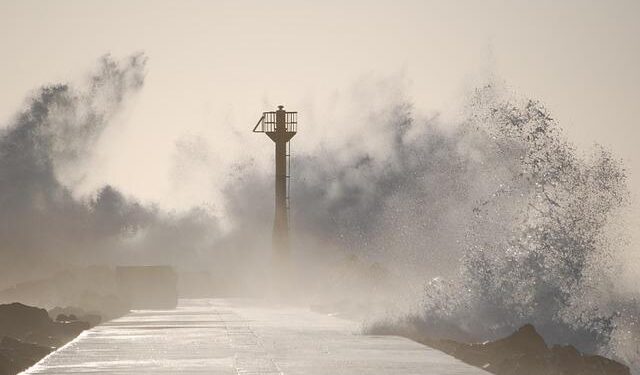China Focus: South China Braces for Super Typhoon Ragasa
As super typhoon Ragasa approaches the southeastern coast, authorities in South China are mobilizing resources and implementing extensive safety measures to protect residents and infrastructure. With wind speeds exceeding 200 kilometers per hour, Ragasa is projected to make landfall in the coming days, prompting the issuance of alarms and widespread preparations across affected provinces. Local governments have activated emergency response plans, including evacuations and the reinforcement of flood defenses, as meteorological agencies urge citizens to take precautions against the severe weather conditions ahead. As the region faces one of the most powerful storms seen in recent years, the resilience and readiness of South China’s communities will be put to the test. Xinhua reports on the latest developments and government actions as the region braces for impact.
Chilling Winds and Rising Waters: How South China Prepared for the Impact of Super Typhoon Ragasa
In a decisive response to the impending devastation of Super Typhoon Ragasa, authorities across South China have mobilized extensive measures aimed at safeguarding lives and infrastructure. Emergency response teams have been dispatched to assess vulnerable areas, while rescue resources have been strategically positioned for rapid deployment. Key preparations include:
- Evacuation plans: Clear routes have been established to ensure a safe and timely relocation of residents from flood-prone regions.
- Storm shelters: Local governments have reinforced designated shelters to accommodate displaced individuals and families.
- Public awareness campaigns: Authorities have intensified efforts to educate residents about safety protocols, emphasizing the importance of preparedness.
Furthermore, local businesses have joined the effort, reinforcing facilities and ensuring their employees have procedures in place. The risk of rising waters has driven municipalities to strengthen flood defenses through measures such as:
| Infrastructure | Action Taken |
|---|---|
| Coastal barriers | Reinforced and inspected for durability |
| Drainage systems | Cleared and maintained to prevent blockages |
| Emergency supplies | Stockpiled food, water, and medical kits for disaster relief |
Authorities remain vigilant, with continuous updates being released to keep the public informed about the storm’s trajectory and the ongoing response efforts. As Ragasa approaches, the collective resilience of South China’s communities is being put to the test, showcasing their preparedness in the face of adversity.
Resilience in the Face of Nature: Community Strategies and Emergency Measures Ahead of Ragasa
As the super typhoon Ragasa approaches, communities across South China are ramping up their preparedness efforts. Local governments and organizations have implemented various strategies to ensure the safety and security of residents. Key initiatives include:
- Emergency Shelters: Establishment of temporary evacuation centers equipped with essential supplies.
- Public Awareness Campaigns: Dissemination of information regarding safety protocols through social media, flyers, and community meetings.
- Coordination with Emergency Services: Close collaboration with local police and fire departments to facilitate quick response operations.
- Infrastructure Reinforcement: Strengthening buildings and bridges to withstand high winds and flooding.
Moreover, community engagement plays a pivotal role in disaster readiness. Residents are encouraged to take part in preparedness drills and to formulate individual response plans that include gathering emergency supplies and establishing communication lines with family members. Additionally, support networks have been formed to help vulnerable populations, such as the elderly and low-income families, ensuring that everyone has access to necessary resources. A recent survey revealed that:
| Preparedness Measure | Community Adoption Rate (%) |
|---|---|
| Emergency Kit Assembly | 85 |
| Evacuation Plan Creation | 76 |
| Participation in Drills | 65 |
| Engagement in Local Meetings | 50 |
Lessons Learned: Understanding the Regional Response to Super Typhoon Challenges in South China
In response to the looming threat of Super Typhoon Ragasa, authorities in South China have implemented a series of strategic measures aimed at minimizing damage and ensuring public safety. Coordination among local governments, meteorological services, and emergency response teams has been crucial. The lessons learned from past typhoons emphasize the significance of timely and transparent communication. This includes not only disseminating meteorological data but also providing residents with clear instructions on evacuation protocols and safety measures. Such proactive engagement helps to reduce panic and ensures that communities are better prepared to face severe weather conditions.
Assessments conducted following previous typhoons revealed several key areas of focus for enhancing regional resilience. These insights have informed actions such as:
- Improved Infrastructure: Reinforcement of buildings and coastal defenses to withstand stronger winds and flooding.
- Community Training: Workshops for locals on emergency preparedness, emphasizing first-aid skills and survival tactics.
- Resource Allocation: Strategic placement of supplies in vulnerable areas to ensure swift access during crises.
Furthermore, collaboration with NGOs and international organizations has fostered a culture of resilience, mobilizing resources and expertise that enhance overall regional preparedness. Continuous evaluation of these practices is essential, as it allows for adaptations that reflect the evolving nature of climate impacts and community needs.
Concluding Remarks
As South China prepares for the impending arrival of super typhoon Ragasa, local authorities and residents are mobilizing to mitigate the potential impact of this powerful storm. With evacuation plans in place and emergency response teams on high alert, the focus remains on safeguarding lives and infrastructure. As weather patterns become increasingly unpredictable, the resilience and preparedness of communities will be tested. In the coming days, all eyes will be on the region as it braces for the challenges ahead, underscoring the significance of collective efforts in the face of natural disasters. Stay tuned for updates as the situation develops, and remember, preparedness is key in the face of uncertainty.














Italy to Deport Egyptian Imam After Controversial Comments at Pro-Palestine Rally